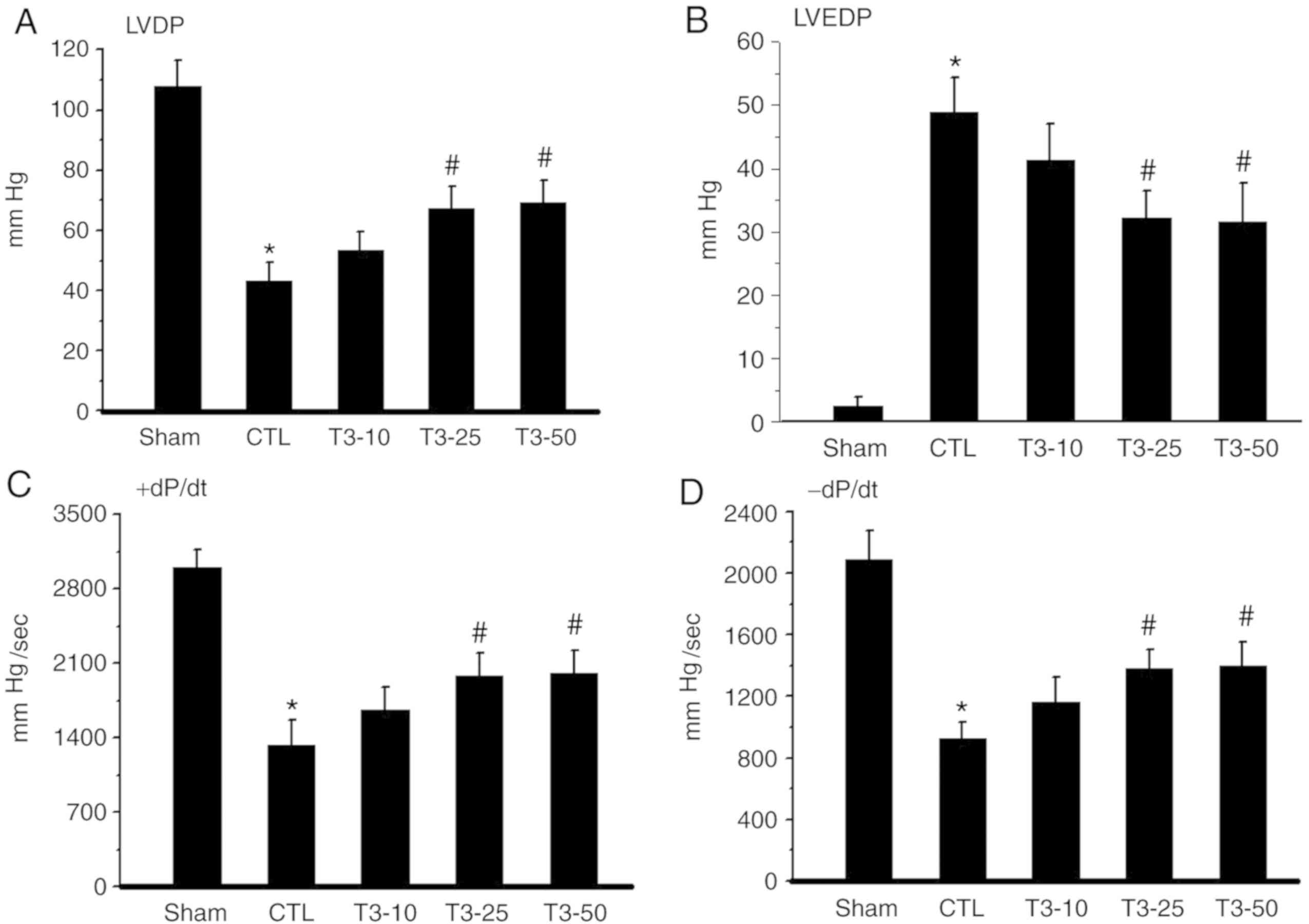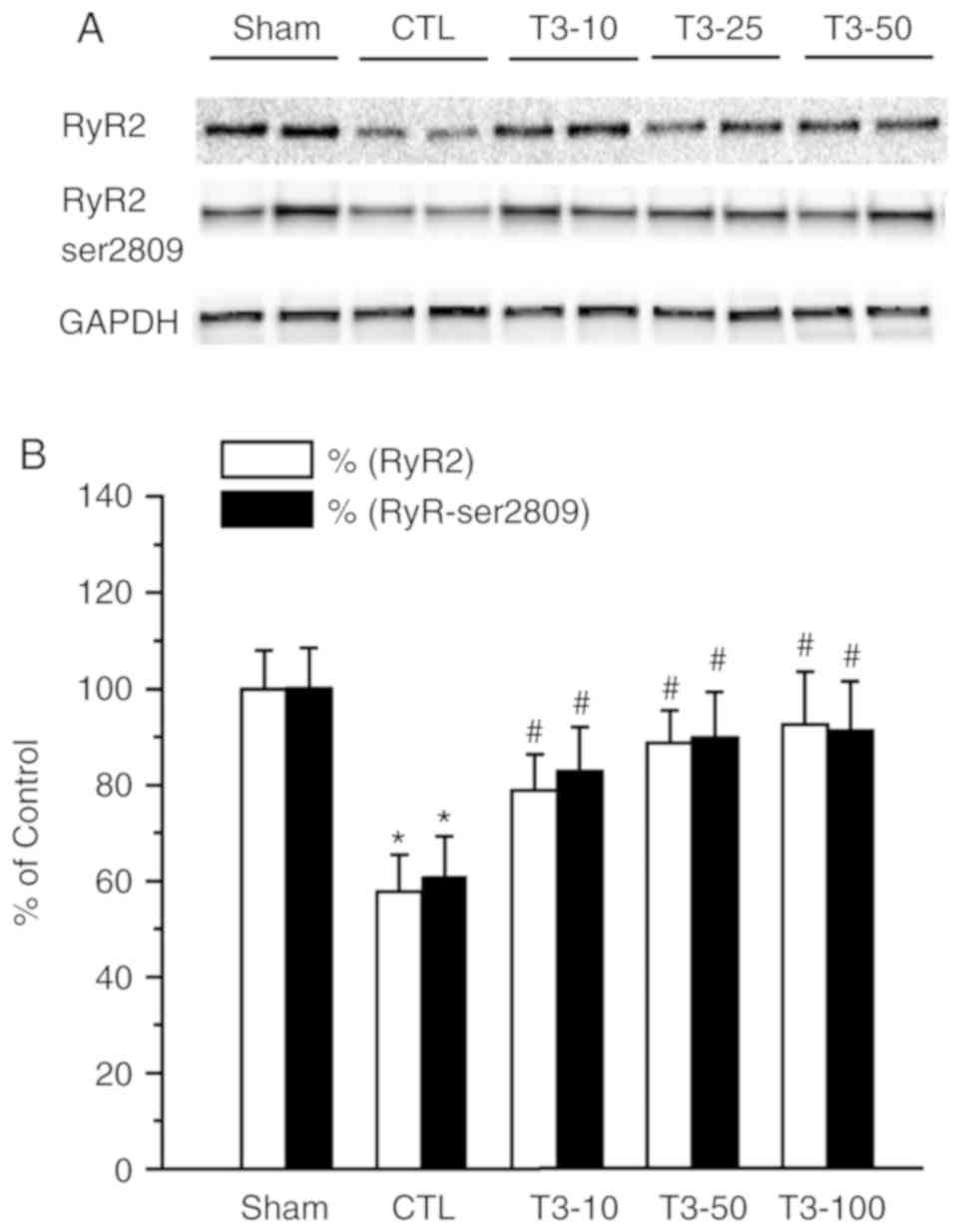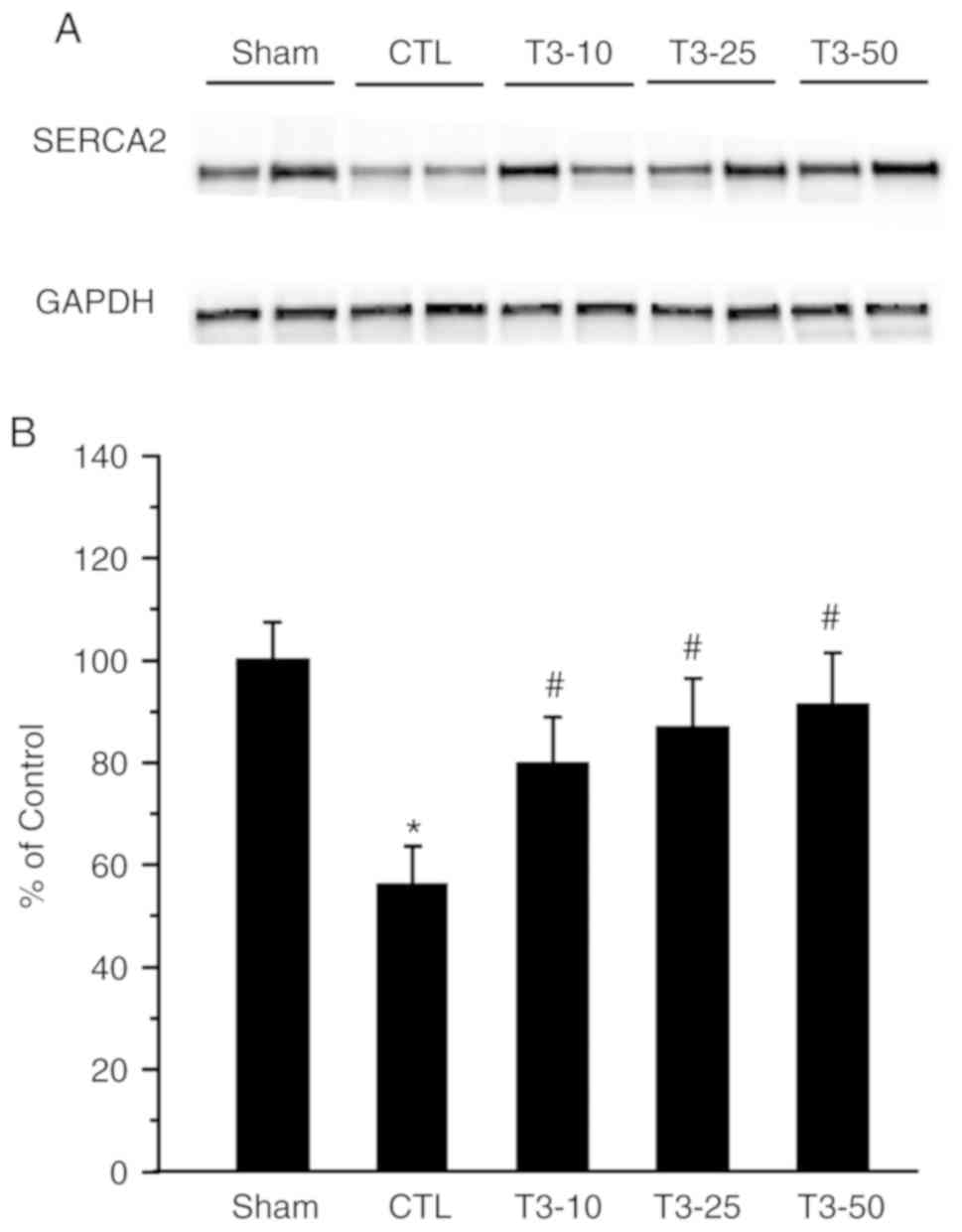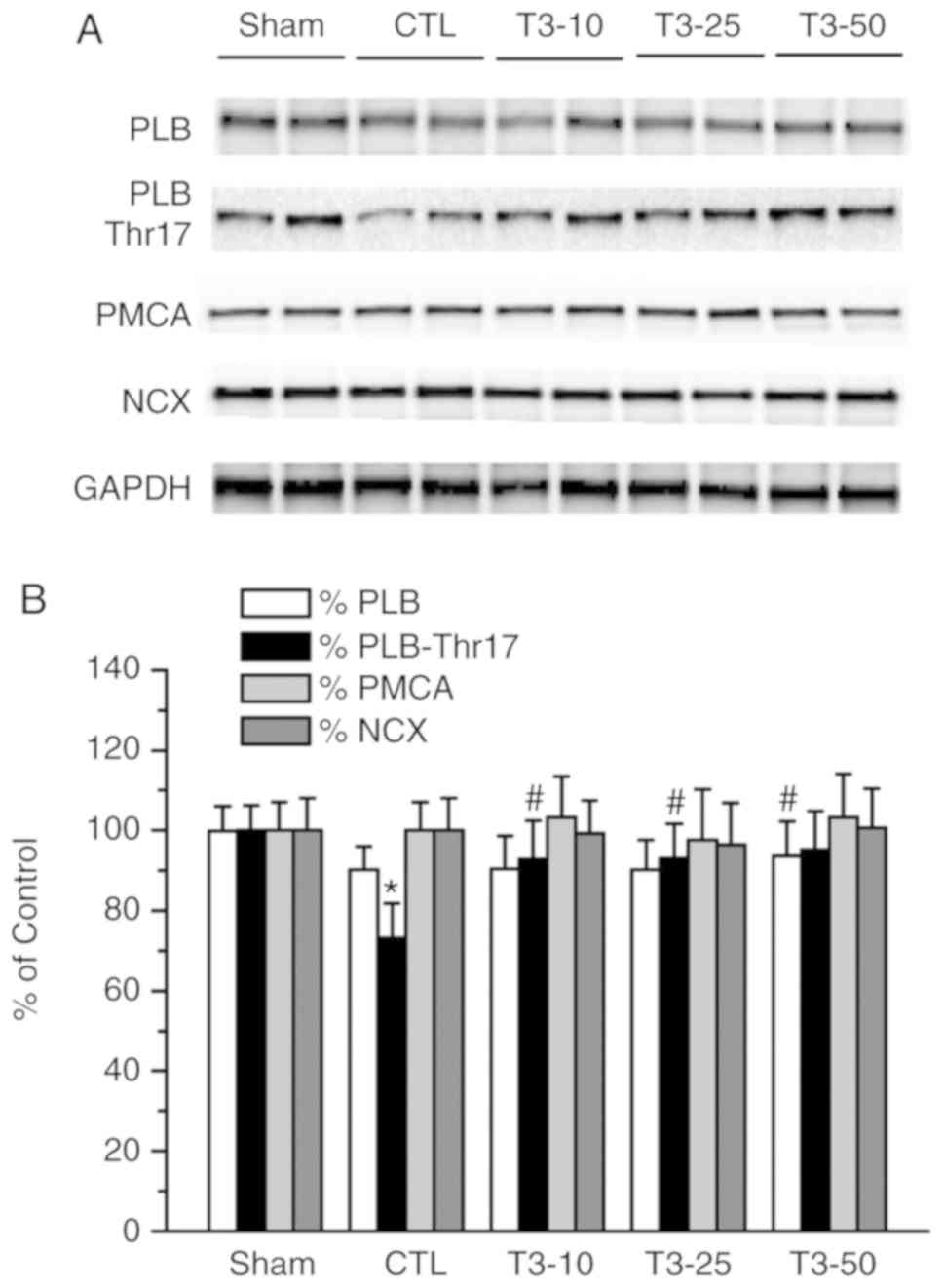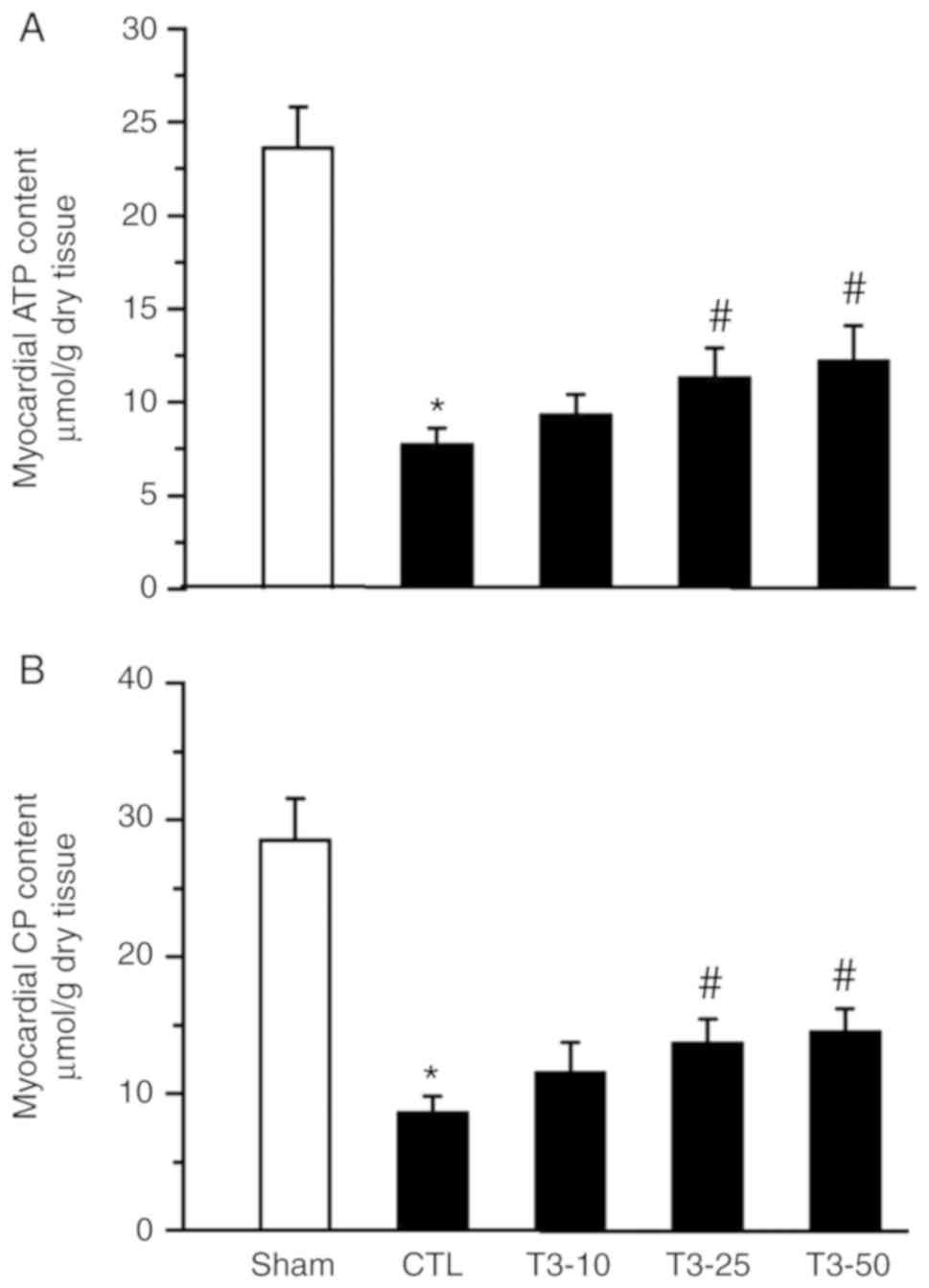Cardioprotective effects of triiodothyronine supplementation against ischemia reperfusion injury by preserving calcium cycling proteins in isolated rat hearts
Corrigendum in: /10.3892/etm.2020.9581
- Authors:
- Published online on: October 21, 2019 https://doi.org/10.3892/etm.2019.8114
- Pages: 4935-4941
Abstract
Introduction
Thyroid hormones have profound effects on the heart and cardiovascular system (1,2). Cardiopulmonary bypass (CPB) leads to a ‘euthyroid-sick’ state (3). This low triiodothyronine (T3) state manifests as low circulating levels of T3 with hemodynamic abnormalities (4). There is a growing body of experimental data that suggests that T3 supplementation improves hemodynamic parameters after ischemic injury in animal models of CPB (5,6) and in isolated heart studies (7,8). Previously, studies using experimental models of ischemia reperfusion (I/R) revealed that T3 administration improved the recovery of post-ischemic cardiac performance and reduced the pro-fibrotic process that leads to adverse cardiac remodeling (2,9–11).
Cytosolic calcium (Ca2+) overload plays a major role in the development of myocardial injury during I/R. The sarcoplasmic reticulum (SR) is critical in Ca2+ uptake via Ca2+-ATPase (SERCA2a) and Ca2+ release via the Ca2+ release channels (ryanodine receptors; RyRs). Human cardiomyocyte calcium handling and phenotype are strongly influenced by T3. ‘Low T3 syndrome’ is observed in the progression of I/R injury (12). It is possible that myocardial protection induced by T3 supplementation involves the protection of SR function. The effects of T3 supplementation on myocardial contractility may be attributed to their effects on intracellular Ca2+ homeostasis. The authors have previously reported a marked Ca2+ overload in the mitochondrial compartment during I/R (13). The ability of T3 supplementation to improve cardiac function, induce the activation of sarcolemma and SERCA2a, and decrease cytosolic (Ca2+) accumulation have been reported previously (13). However, the mechanisms that underlie these cardioprotective effects of thyroid hormone remain largely unknown. In the present study, it was hypothesized that the cardiac protection of T3 supplementation against I/R injury is associated with the preservation of Ca2+-cycling proteins and high-energy phosphate contents.
Materials and methods
Animals
Adult male Sprague-Dawley rats (n=50; weight, 350–425 g) were obtained from the Animal Center of Soochow University (Suzhou, China). Rats were fed a standard diet and were housed at 25°C with 60% humidity under a 12 h light-dark cycle. All rats were allowed access to food and water ad libitum for one week before experiments. The protocol was reviewed and approved by the Institutional Animal Care and Use Committee of Nanjing University.
Langendorff isolated heart preparation and measurements
The methods employed have been previously described (13). Briefly, rats were anesthetized and decapitated when unresponsive to noxious stimulation. The hearts were excised and perfused in the Langendorff mode at a perfusion pressure equivalent to 80 mmHg. Perfusate and bath temperatures were maintained at 37.2±0.1°C using a thermostatically controlled water circulator (Lauda E100; Lauda Dr R Wobser GmbH & Co., KG). Left ventricular pressure (LVP) and coronary flow (CF) were measured at a constant temperature and perfusion pressure (100 mmHg). Coronary inflow and coronary venous Na+, K+, Ca2+ and pH were measured offline with an intermittently self-calibrating analyzer system (Radiometer Copenhagen ABL 505; Radiometer, Ltd.). Coronary outflow (coronary sinus) O2 tension was also measured online continuously with a Clark-type O2 electrode (203B; Instech Laboratories, Inc.). Myocardial O2 consumption (MVO2) was calculated as [(coronary flow/g heart weight) × (arterial pO2-venous pO2)] × 24 µl O2/ml at 760 mmHg; and cardiac work efficiency was calculated as [systolic-diastolic LVP × HR]/MVO2. At the end of the experiments, the hearts were freeze-clamped and stored at −80°C until subsequent use in western blot assays.
Experimental group establishment
Animals were randomly divided into 5 groups. The untreated sham (non-ischemic) group (Sham, n=10) was perfused for 225 min and after 15 min the equilibration/stabilization of functional parameters were employed; hearts were not subjected to ischemia. Ischemia groups underwent 15 min of stabilization and 60 min perfusion with or without T3 administration at three different doses (10, 25 and 50 nM), followed by 30 min ischemia and 120 min reperfusion [n=10 each for the control (CTL), T3−10, T3−25 and T3−50 groups]. The range of doses was selected according to a previous study (14). A three-way stopcock, located immediately above the aortic cannula, allowed the induction of global, no-flow ischemia.
Western blot assays for SR and sarcomlemmal Ca2+-cycling and -regulating proteins
Western blot assays were conducted as previously described (15). Briefly, aliquots of homogenate samples (20 µg protein/lane) were solubilized in Laemmli sample buffer (cat. no. S3401; Sigma-Aldrich; Merck KGaA) and fractionated by SDS-PAGE using a 4–20% gel. After transfer to nitrocellulose membranes, membranes were blocked with 5% nonfat milk for 1.5 h at room temperature in phosphate-buffered saline and probed with primary antibodies against RyR2 (cat. no. MA3-916; 1:2,000,), SERCA2a (cat. no. 2A7-A1; 1:2,000), Phospholamban (cat. no. 2D12; PLB; 1:1,000), and sarcolemmal Ca2+-adenosine triphosphatase (PMCA; cat. no. 5F10; 1:1,000). The above antibodies were purchased from Affinity Bioreagents, Inc. The sodium-calcium exchanger (cat. no. ab3516P; NCX; 1:1,000) was obtained from Sigma-Aldrich; Merck KGaA. RyR-ser2809 and PLB-Thr17 were purchased from Badrilla., Ltd., (1:1,000). Secondary antibodies (m-lgGk BP-HRP, cat. no. sc-516102, Santa Cruz Biotechnology; 1:20,000) were conjugated to horseradish peroxidase. Immunoreactive bands were visualized by enhanced chemiluminescence (SuperSignal™ west pico PLUS chemilumiluminescent substrate, cat. no. 34577; Pierce; Thermo Fisher Scientific, Inc.). The amount of protein was determined by densitometry using Kodak 1D software (version 3.4.5; Sigma-Aldrich; Thermo Fisher Scientific, Inc.) and normalized to protein load. Positive (purified proteins) and negative (blocking peptide or blot without primary antibodies) controls were used to establish the specificity of the protein signals.
Biochemical analysis
At the end of reperfusion, the hearts were freeze-clamped with aluminum tongs pre-cooled with liquid nitrogen as described previously (16), to measure myocardial ATP and creatine phosphate (CP) levels. Briefly, frozen ventricles were pulverized and mixed with 0.3 M HClO4 and 0.25 mM EDTA under liquid nitrogen cooling. The extract was centrifuged at 8,000 × g for 15 min at 4°C and the resulting supernatant was sampled to measure myocardial ATP and CP using the high pressure liquid chromatography method as previously described (16). Myocardial CP was converted to ATP via the creatine kinase enzymatic reaction.
Statistical analysis
All data are expressed as the mean ± standard deviation. Statistical analysis used SPSS 20.0 (IBM Corp.). A two-way analysis of variance was used to assess the overall difference between groups. Student Newman Keuls' post hoc test was used for multiple comparisons between the different groups. All experiments were repeated three times. P<0.05 was considered to indicate a statistically significant difference.
Results
Cardiac performance
Table I summarizes the changes in the indices for coronary flow, heart rate, MVO2 and cardiac efficiency in the Sham, CTL, T3−10, T3−25 and T3−50 groups before 30 min ischemia, and at 120 min of reperfusion. The heart rates of all the groups were similar prior to ischemia, but decreased after I/R. There was no significant difference among the different groups. Coronary flow was much lower than baseline throughout reperfusion in each of the ischemia groups, but it was increased in all of the T3 treated groups (returned to 55% in T3−10, 64% in T3−25 and 67% in T3−50) compared with the CTL group (47%) throughout reperfusion. After 120 min of reperfusion, MVO2 and cardiac efficiency were increased in the T3 administrated groups compared with in the CTL group, but remained lower than the baseline in all of the ischemic groups. Both parameters of MVO2 and cardiac efficiency in the T3−25 and T3−50 groups were significantly increased compared with those in the CTL group (P<0.05; Table I).
Table I.Cardiac effects in Sham, CTL, T3 10 nM, T3 25 nM and T3 50 nM before and after ischemia reperfusion. |
Left ventricular developed pressure (LVDP) was decreased after I/R compared with the baseline in each group. LVDP was increased in the T3 treated groups compared with in the CTL group upon reperfusion. The improvement in LVDP was significantly different in the T3−25 and T3−50 groups compared with the CTLgroup (P<0.05). There was no significant difference in the T3−10 group (Fig. 1A). Hearts subjected to global ischemia for 30 min showed a marked increase in LVDP. However, a significant reduction in LVEDP was observed with T3 25 or 50 nM treatment (P<0.05; Fig. 1B). Cardiac contractility +dP/dt and relaxation -dP/dt (Fig. 1C and D) were reduced during ischemia in all groups. Upon reperfusion, contractility increased but still remained lower than that recorded before ischemia throughout reperfusion in each group. T3 administration at doses of 25 and 50 nM significantly improved contractile recovery in I/R injury hearts (P<0.05). This was evidenced by a greater recovery in LVDP and +dP/dt and -dP/dt, respectively, when compared with the pre-ischemic values.
Effect of T3 supplementation on the SR Ca2+ regulatory proteins
There was a significant reduction in the density of RyR2 and the phosphorylation status of RyR2 at S2809 in the CTL group (P<0.05). Treatment with T3 in I/R hearts significantly prevented the attenuation of RyR2 density and Ser-2809 (P<0.05 Fig. 2). Fig. 3 presents the protein density of SERCA2a in the control and I/R hearts that were treated with or without T3 supplementation. Compared with the non-ischemic values, SERCA2a expression decreased significantly after I/R injury (P<0.05).
Effect of T3 supplementation on sarcomlemmal Ca2+- regulatory protein
The density of PLB was lower in all the ischemia groups; however, there was no significant difference when compared with the Sham group (Fig. 4). The phosphorylation of PLB at Thr-17 significantly decreased after 30 min of ischemia compared with the non-ischemia group (Sham group; P<0.05). T3 treatment at all three doses before ischemia attenuated this decrease and a significant difference was detected in all T3 dose groups compared with the ISC group (P<0.05). The immunoblots of the protein expression of sarcolemmal PMCA and NCX revealed that there were no changes in PMCA and NCX after I/R in the CTL and T3 supplementation groups.
ATP and CP content
The ATP and CP content of transmural sections taken from the left ventricular free wall at the end of reperfusion were determined. In the CTL and T3 groups, the ATP contents were 6.7±0.9, 9.3±1.1, 11.3±1.6 and 12.2±1.9 µmol/g, respectively; the CP contents were 8.6±1.2, 11.5±2.3, 13.7±1.8 and 14.5±1.7 µmol/g at the end of reperfusion, respectively. The contents of ATP and CP were better preserved in the T3 (10, 25 and 50 nM) treated groups compared with in the CTL group (Fig. 5).
Discussion
A number of studies have confirmed that a cardiopulmonary bypass affects thyroid hormone metabolism to reduce circulating free T3, which leads to a ‘euthyroid-sick’ state. It is not clear how acute stress-induced hypothyroidism affects the myocardium pathophysiological change; however, previous studies (4,17) have suggested that T3 is a positive inotrope and acts by improving the ‘aerobic capacity’ of the myocardium after ischemia. This then leads to an enhanced availability of myocardial high-energy phosphates for contractile work (4). The results of the present study demonstrated that the recovery of myocardial function was improved after ischemia by treatment with T3 (at 10, 25 and 50 nM). The supplementation of thyroid hormone improved the recovery of cardiac function and persisted throughout the reperfusion interval. This is consistent with data reported by Klemperer et al (18), in which acute administration of T3 to post-ischemic hearts improved the preload recruitable stroke work area, but had no effect on the preload stroke work area of the non-ischemic hearts. In the present study, T3 at 10 nM, ten times the physiological dose, produced a measurable effect. T3 at 25 nM had a greater effect on post-ischemic recovery, but there was no additional recovery at 50 nM. T3 had a similar salutary effect on the recovery of the diastolic chamber, with a direct relationship between the dose of T3 required and the severity of the injury. The observation that T3 (50 nM) did not make additional improvements is important. It suggests the need to further define the effective therapeutic range for T3 supplementation.
T3 supplementation could improve cardiac functions and limit infarct size against I/R injury (10). Previous studies have clearly shown that in addition to binding to nuclear-localized receptors, T3 can also activate signaling processes at the plasma membrane, in mitochondria or within the cytosol by targeting T3 receptors or other proteins (2,19). Although the heart may be capable of synthesizing 1 mg of protein per g of heart tissue per h (20), the rapid post-ischemic recovery of cardiac function evident in the present study suggests that the site of action targeted by T3 is more likely to be in the plasma membrane or cytosol. There is also strong evidence that the accumulation of cytosolic Ca2+ during I/R is highly correlated with the severity of injury (13). The present study using isolated hearts revealed a marked improvement in cardiac function by T3 supplementation before I/R, which is consistent with previous studies (2,8,21). As the inhibition of calpain prevented the I/R-induced degradation of key SR Ca2+ cycling proteins (such as RyR2 and SERCA2a) and improved contractile function (22), the present study measured the protein contents of the Ca2+ release channel, Ca2+ uptake and other Ca2+-regulating proteins. The results demonstrated that an I/R-induced depression in cardiac performance was associated with a downregulation of the major SR Ca2+-cycling proteins. This downregulation could be attenuated by T3 supplementation before ischemia.
RYR2 is a protein found primarily in cardiac muscle. The RYR2 protein functions as the major component of a calcium channel located in the SR that supplies ions to the cardiac muscle during systole to initiate contraction (23). In the present study, T3 supplementation improved cardiac function recovery in I/R hearts and was accompanied with the preservation of RyR2 protein content. To date, it has been demonstrated that Ser-2809 is one of the main sites of phosphorylation on RYR2. Phosphorylation of RYR2 by CaMKII, or protein kinase A (PKA), at Ser-2809 induced channel function changes in vitro. These changes include an increase in the probability of being open (24). In the present study a low level of Ser-2809 phosphorylation was observed in the CTL group, but marked Ser-2809 phosphorylation was expressed following supplementation with T3. The results suggest that T3 may facilitate the phosphorylation of RYR2 by CaMKII or PKA.
SERCA2 in cardiac muscle plays an important role in the muscle's overall contractility status. Improved cardiac SR function by T3 supplementation against I/R injury may partly contribute to a higher level of the protein content of major SR Ca2+ uptake proteins including SERCA2a and PLB, a 52 amino acid phosphoprotein. Unphosphorylated PLB inhibits SERCA2a, but the phosphorylation of PLB prevents the inhibition of SERCA2a at either Ser-16 by PKA or Thr-17 by CaMKII, thereby increasing SERCA2a activity and the rate of Ca2+ uptake by the SR (25). The present results showed that the protein level of PLB was decreased in I/R hearts and SERCA2a levels were reduced even more. Therefore it is in agreement with a previous study in which the PLB/SERCA2a interaction controlled the calcium content of the SR and ultimately controlled cardiac contractility (25). A decrease in the phosphorylation of PLB, along with an increase in the PLB/SERCA2a ratio was observed (data not shown) in the CTL group, suggesting the strong inhibitory effect of PLB on SERCA2a in I/R hearts. Phosphorylation of the PKA substrate PLB is a critical determinant of Ca2+ re-entry into the SR and is coordinated by CaMKII and PKA. In the present study, PLB phosphorylation on Thr-17 was decreased during I/R. PLB phosphorylation was downregulated in I/R hearts, suggesting that the rate of Ca2+ uptake by the SR decreased due to the inhibition of SERCA2a. The present results demonstrated that T3 supplementation improved PLB phosphorylation at Thr-17 in I/R hearts. T3 supplementation increased the PLB/SERCA2a ratio by valid preservation of SERCA2a. The phosphorylation of PLB by T3 reduced the inhibition of SERCA2a and therefore enhanced SR Ca2+ uptake in I/R hearts. T3 supplementation inhibited ATP-dependent Ca2+ uptake in isolated cardiac SR vesicles (26). There is evidence that alterations in SR Ca2+ cycling function are components of the impaired SR Ca2+ uptake, Ca2+ release and the content of Ca2+-cycling proteins (23,27); the beneficial effect of T3 supplementation on SR Ca2+ cycling function may contribute to the attenuation of I/R-induced changes in SR function and protein content.
Cytosolic Ca2+ regulates several cellular processes and its concentration is, in turn, finely regulated by various channels, pumps and exchangers. The NCX and the PMCA pump are two concurrent mechanisms for Ca2+ extrusion from the cell. There is a very large transmembrane electrochemical Ca2+ gradient driving the entry of the ion into cells, yet it is very important that they maintain low concentrations of Ca2+ for appropriate cell signaling. Thus, it is necessary for cells on pumps to remove Ca2+. PMCA and NCX together are the main regulators of intracellular Ca2+ concentrations (25). In this manner, intracellular Ca2+ and SR Ca2+ content are regulated and maintained. The present results revealed no alterations in PMCA and NCX contents after I/R. Furthermore, T3 supplementation did not affect the content of PMCA or NCX.
The results obtained from measuring myocardial ATP and CP in the present study suggested that T3 induces inotropic effects via the rapid replacement and maintenance of high energy phosphate stores within the myocardium. The administration of T3 led to the return of normal mitochondrial function, reactivation of the tricarboxylic acid cycle and full aerobic metabolism; tissue lactate levels were reduced and high energy phosphate stores were more rapidly replaced (4). T3 may lead to both the increased synthesis of high energy stores and increased utilization of such stores, which results in improved myocardial function. This hypothesis is also supported by previous studies (2,4). Sterling et al (28) demonstrated the rapidly increased synthesis of ATP production secondary to mitochondrial stimulation in both euthyroid and hypothyroid rats treated with T3.
In conclusion, the results of the present study demonstrated that T3 supplementation improves left ventricular function after I/R in isolated rat hearts by preserving major Ca2+ cycling proteins. Rapid cardiac functional improvements by T3 supplementation suggested that these effects may be mediated through T3 binding at the plasma membrane or SR rather than at the nuclear level. Increased synthesis of myocardial high energy phosphate ATP and CP are attributed to the improvement of myocardial function. T3-induced preservation of calcium cycling proteins potentially involves the direct inhibition of protease activities. However, the mechanisms underlying these effects require further elucidation.
Acknowledgements
The authors would like to thank Dr Chen Wang (Department of Anesthesiology, The Affiliated Suzhou Science and Technology Town Hospital of Nanjing Medical University) for his technical assistance in the study and for reading the manuscript.
Funding
The present study was supported by the Suzhou ‘Kejiaoxinwei’ program (grant no. KJXW2015062), the Xiangcheng Science and Technology Program (grants nos. XJ201657 and 201704), the Suzhou Science and Technology Bureau (grant no. SS201756), and the Suzhou Gaoxin District Science and Technology Plan (grant no. 2017Z004).
Availability of data and material
The datasets used and/or analyzed during the current study are available from the corresponding author on reasonable request.
Authors' contributions
Conceived and designed the experiments: LF, LL and JA. Performed the experiments: LF, ZX, JL, LH and SQ. Analyzed the data: LF, LL and JA. Contributed reagents/materials/analysis tools: LF, ZX, JL, LH and SQ. Wrote the paper: LF, LL and JA. All authors read and approved the final manuscript.
Ethics approval and consent to participate
The protocol was reviewed and approved by the Institutional Animal Care and Use Committee of Nanjing Medical University.
Patient consent for publication
Not applicable.
Competing interests
The authors declare that they have no competing interests.
Glossary
Abbreviations
Abbreviations:
|
T3 |
triiodothyronine |
|
I/R |
ischemic reperfusion |
|
RyR2 |
Ca2+-release channels |
|
SERCA2a |
Ca2+-adenosine triphosphatase |
|
PLB |
phospholamban |
|
PMCA |
sarcolemmal Ca2+-adenosine triphosphatase |
|
NCX |
sodium-calcium exchanger |
|
CPB |
cardiopulmonary bypass |
|
Ca2+- |
calcium |
|
SR |
sarcoplasmic reticulum |
|
RyRs |
ryanodine receptors |
|
LVP |
left ventricular pressure |
|
CF |
coronary flow |
|
MVO2 |
myocardial O2 consumption |
|
ATP |
adenosine triphosphate |
|
CP |
creatine phosphate |
|
LVDP |
Left ventricular developed pressure |
|
CaMKII |
calmodulin-dependent kinase II |
|
PKA |
protein kinase A |
References
|
Li L, Guo CY, Yang J, Jia EZ, Zhu TB, Wang LS, Cao KJ, Ma WZ and Yang ZJ: Negative association between free triiodothyronine level and international normalized ratio in euthyroid subjects with acute myocardial infarction. Acta Pharmacol Sin. 32:1351–1356. 2011. View Article : Google Scholar : PubMed/NCBI | |
|
Ragone MI, Bonazzola P, Colareda GA and Consolini AE: Cardioprotective effect of hyperthyroidism on the stunned rat heart during ischaemia-reperfusion: Energetics and role of mitochondria. Exp Physiol. 100:680–697. 2015. View Article : Google Scholar : PubMed/NCBI | |
|
Holland FW II, Brown PS Jr and Clark RE: Acute severe postischemic myocardial depression reversed by triiodothyronine. Ann Thorac Surg. 54:301–305. 1992. View Article : Google Scholar : PubMed/NCBI | |
|
Novitzky D and Cooper DK: Thyroid hormone and the stunned myocardium. J Endocrinol. 223:R1–R8. 2014. View Article : Google Scholar : PubMed/NCBI | |
|
Velissaris T, Tang AT, Wood PJ, Hett DA and Ohri SK: Thyroid function during coronary surgery with and without cardiopulmonary bypass. Eur J Cardiothorac Surg. 36:148–154. 2009. View Article : Google Scholar : PubMed/NCBI | |
|
Priest JR, Slee A, Olson AK, Ledee D, Morrish F and Portman MA: Triiodothyronine supplementation and cytokines during cardiopulmonary bypass in infants and children. J Thorac Cardiovasc Surg. 144:938–943.e2. 2012. View Article : Google Scholar : PubMed/NCBI | |
|
Forini F, Lionetti V, Ardehali H, Pucci A, Cecchetti F, Ghanefar M, Nicolini G, Ichikawa Y, Nannipieri M, Recchia FA and Iervasi G: Early long-term L-T3 replacement rescues mitochondria and prevents ischemic cardiac remodelling in rats. J Cell Mol Med. 15:514–524. 2011. View Article : Google Scholar : PubMed/NCBI | |
|
Pingitore A, Chen Y, Gerdes AM and Iervasi G: Acute myocardial infarction and thyroid function: New pathophysiological and therapeutic perspectives. Ann Med. 44:745–757. 2012. View Article : Google Scholar : PubMed/NCBI | |
|
Forini F, Kusmic C, Nicolini G, Mariani L, Zucchi R, Matteucci M, Iervasi G and Pitto L: Triiodothyronine prevents cardiac ischemia/reperfusion mitochondrial impairment and cell loss by regulating miR30a/p53 axis. Endocrinology. 155:4581–4590. 2014. View Article : Google Scholar : PubMed/NCBI | |
|
Nicolini G, Forini F, Kusmic C, Pitto L, Mariani L and Iervasi G: Early and short-term triiodothyronine supplementation prevents adverse postischemic cardiac remodeling: Role of transforming growth factor-β1 and antifibrotic miRNA signaling. Mol Med. 21:900–911. 2016. View Article : Google Scholar : PubMed/NCBI | |
|
Bi W, Jia J, Pang R, Nie C, Han J, Ding Z, Liu B, Sheng R, Xu J and Zhang J: Thyroid hormone postconditioning protects hearts from ischemia/reperfusion through reinforcing mitophagy. Biomed Pharmacother. 118:1092202019. View Article : Google Scholar : PubMed/NCBI | |
|
Forini F, Paolicchi A, Pizzorusso T, Ratto GM, Saviozzi M, Vanini V and Iervasi G: 3,5,3′-Triiodothyronine deprivation affects phenotype and intracellular [Ca2+]i of human cardiomyocytes in culture. Cardiovasc Res. 51:322–330. 2001. View Article : Google Scholar : PubMed/NCBI | |
|
An J, Rhodes SS, Jiang MT, Bosnjak ZJ, Tian M and Stowe DF: Anesthetic preconditioning enhances Ca2+ handling and mechanical and metabolic function elicited by Na+-Ca2+ exchange inhibition in isolated hearts. Anesthesiology. 105:541–549. 2006. View Article : Google Scholar : PubMed/NCBI | |
|
Pantos C, Mourouzis I, Saranteas T, Clavé G, Ligeret H, Noack-Fraissignes P, Renard PY, Massonneau M, Perimenis P, Spanou D, et al: Thyroid hormone improves postischaemic recovery of function while limiting apoptosis: A new therapeutic approach to support hemodynamics in the setting of ischaemia-reperfusion? Basic Res Cardiol. 104:69–77. 2009. View Article : Google Scholar : PubMed/NCBI | |
|
An J, Bosnjak ZJ and Jiang MT: Myocardial protection by isoflurane preconditioning preserves Ca2+ cycling proteins independent of sarcolemmal and mitochondrial KATP channels. Anesth Analg. 105:1207–1213. 2007.table of contents. View Article : Google Scholar : PubMed/NCBI | |
|
Sasamori J, Abe Y, Marunouchi T, Manome Y, Uchibori T and Tanonaka K: Effects of 2-octynyladenosine (YT-146) on mitochondrial function in ischemic/reperfused rat hearts. Biol Pharm Bull. 38:1946–1953. 2015. View Article : Google Scholar : PubMed/NCBI | |
|
Ranasinghe AM, Quinn DW, Pagano D, Edwards N, Faroqui M, Graham TR, Keogh BE, Mascaro J, Riddington DW, Rooney SJ, et al: Glucose-insulin-potassium and tri-iodothyronine individually improve hemodynamic performance and are associated with reduced troponin I release after on-pump coronary artery bypass grafting. Circulation. 114 (1 Suppl):I245–I250. 2006. View Article : Google Scholar : PubMed/NCBI | |
|
Klemperer JD, Zelano J, Helm RE, Berman K, Ojamaa K, Klein I, Isom OW and Krieger K: Triiodothyronine improves left ventricular function without oxygen wasting effects after global hypothermic ischemia. J Thorac Cardiovasc Surg. 109:457–465. 1995. View Article : Google Scholar : PubMed/NCBI | |
|
Dyke CM, Yeh T Jr, Lehman JD, Abd-Elfattah A, Ding M, Wechsler AS and Salter DR: Triiodothyronine-enhanced left ventricular function after ischemic injury. Ann Thorac Surg. 52:14–19. 1991. View Article : Google Scholar : PubMed/NCBI | |
|
Umeda PK, Darling DS, Kennedy JM, Jakovcic S and Zak R: Control of myosin heavy chain expression in cardiac hypertrophy. Am J Cardiol. 59:49A–55A. 1987. View Article : Google Scholar : PubMed/NCBI | |
|
Accorroni A, Saponaro F and Zucchi R: Tissue thyroid hormones and thyronamines. Heart Fail Rev. 21:373–390. 2016. View Article : Google Scholar : PubMed/NCBI | |
|
Singh RB, Chohan PK, Dhalla NS and Netticadan T: The sarcoplasmic reticulum proteins are targets for calpain action in the ischemic-reperfused heart. J Mol Cell Cardiol. 37:101–110. 2004. View Article : Google Scholar : PubMed/NCBI | |
|
Eisner DA, Caldwell JL, Kistamás K and Trafford AW: Calcium and excitation-contraction coupling in the heart. Circ Res. 121:181–195. 2017. View Article : Google Scholar : PubMed/NCBI | |
|
Mourouzis I, Mantzouratou P, Galanopoulos G, Kostakou E, Roukounakis N, Kokkinos AD, Cokkinos DV and Pantos C: Dose-dependent effects of thyroid hormone on post-ischemic cardiac performance: Potential involvement of Akt and ERK signalings. Mol Cell Biochem. 363:235–243. 2012. View Article : Google Scholar : PubMed/NCBI | |
|
del Monte F, Harding SE, Dec GW, Gwathmey JK and Hajjar RJ: Targeting phospholamban by gene transfer in human heart failure. Circulation. 105:904–907. 2002. View Article : Google Scholar : PubMed/NCBI | |
|
Pantos C, Mourouzis I, Saranteas T, Brozou V, Galanopoulos G, Kostopanagiotou G and Cokkinos DV: Acute T3 treatment protects the heart against ischemia-reperfusion injury via TRalpha1 receptor. Mol Cell Biochem. 353:235–241. 2011. View Article : Google Scholar : PubMed/NCBI | |
|
Temsah RM, Kawabata K, Chapman D and Dhalla NS: Preconditioning prevents alterations in cardiac SR gene expression due to ischemia-reperfusion. Am J Physiol Heart Circ Physiol. 282:H1461–H1466. 2002. View Article : Google Scholar : PubMed/NCBI | |
|
Sterling K, Brenner MA and Sakurada T: Rapid effect of triiodothyronine on the mitochondrial pathway in rat liver in vivo. Science. 210:340–342. 1980. View Article : Google Scholar : PubMed/NCBI |



